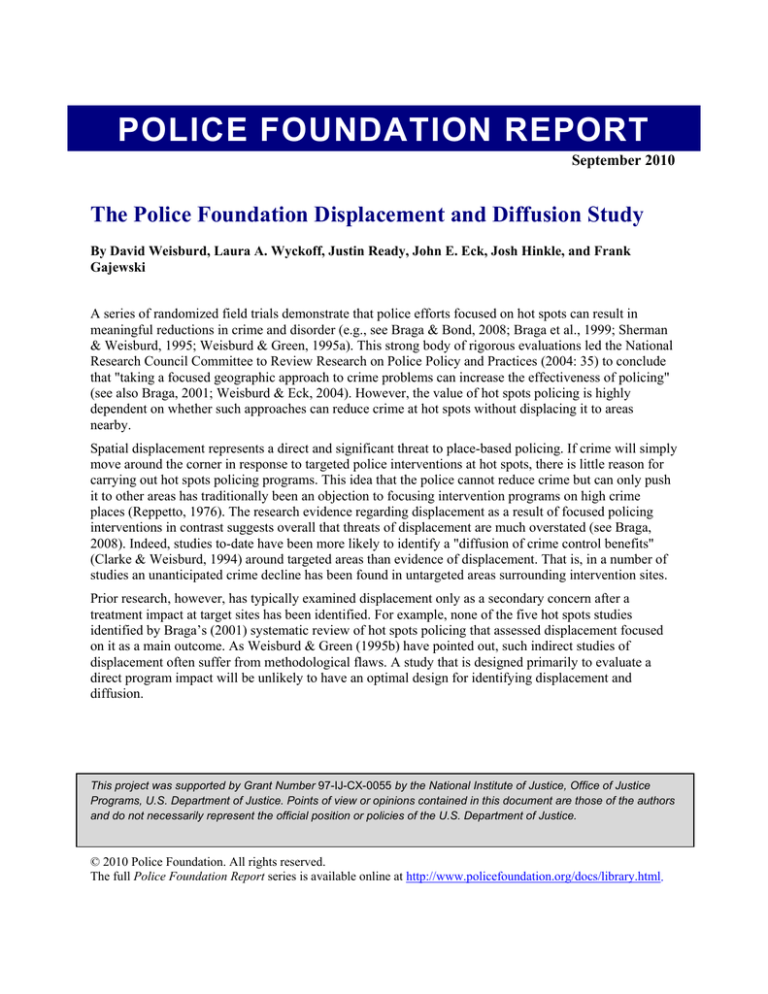
POLICE FOUNDATION REPORT
D
D
September 2010
The Police Foundation Displacement and Diffusion Study
By David Weisburd, Laura A. Wyckoff, Justin Ready, John E. Eck, Josh Hinkle, and Frank
Gajewski
A series of randomized field trials demonstrate that police efforts focused on hot spots can result in
meaningful reductions in crime and disorder (e.g., see Braga & Bond, 2008; Braga et al., 1999; Sherman
& Weisburd, 1995; Weisburd & Green, 1995a). This strong body of rigorous evaluations led the National
Research Council Committee to Review Research on Police Policy and Practices (2004: 35) to conclude
that "taking a focused geographic approach to crime problems can increase the effectiveness of policing"
(see also Braga, 2001; Weisburd & Eck, 2004). However, the value of hot spots policing is highly
dependent on whether such approaches can reduce crime at hot spots without displacing it to areas
nearby.
Spatial displacement represents a direct and significant threat to place-based policing. If crime will simply
move around the corner in response to targeted police interventions at hot spots, there is little reason for
carrying out hot spots policing programs. This idea that the police cannot reduce crime but can only push
it to other areas has traditionally been an objection to focusing intervention programs on high crime
places (Reppetto, 1976). The research evidence regarding displacement as a result of focused policing
interventions in contrast suggests overall that threats of displacement are much overstated (see Braga,
2008). Indeed, studies to-date have been more likely to identify a "diffusion of crime control benefits"
(Clarke & Weisburd, 1994) around targeted areas than evidence of displacement. That is, in a number of
studies an unanticipated crime decline has been found in untargeted areas surrounding intervention sites.
Prior research, however, has typically examined displacement only as a secondary concern after a
treatment impact at target sites has been identified. For example, none of the five hot spots studies
identified by Braga’s (2001) systematic review of hot spots policing that assessed displacement focused
on it as a main outcome. As Weisburd & Green (1995b) have pointed out, such indirect studies of
displacement often suffer from methodological flaws. A study that is designed primarily to evaluate a
direct program impact will be unlikely to have an optimal design for identifying displacement and
diffusion.
This project was supported by Grant Number 97-IJ-CX-0055 by the National Institute of Justice, Office of Justice
Programs, U.S. Department of Justice. Points of view or opinions contained in this document are those of the authors
and do not necessarily represent the official position or policies of the U.S. Department of Justice.
© 2010 Police Foundation. All rights reserved.
The full Police Foundation Report series is available online at http://www.policefoundation.org/docs/library.html.
The main focus of this study is immediate spatial displacement or diffusion to areas near the targeted sites
of a police intervention. This research represents the first attempt we are aware of to examine
displacement as a primary outcome, and thus it was designed to optimize the identification of
displacement and diffusion outcomes. Do focused prevention efforts simply move crime around the
corner? Or, conversely, do hot spots policing efforts that bring unusually high dosages of police presence
to target areas diffuse crime prevention benefits to areas immediately surrounding the target areas? To
answer these questions, two study sites were selected in Jersey City, New Jersey. One area had a high
concentration of drug and violent crime; the other was the site of a strong concentration of prostitution
activity.
Methodology1
Intervention sites
In each site, small target areas were selected to receive intensive police enforcement (see Figures 1 and
2). To capture any displacement or diffusion effects, two catchment areas surrounding the targeted areas
were defined for each site. We divided the catchment areas into an area immediately next to the target
area (catchment area 1) and an area more removed (catchment area 2) to allow us to distinguish between
movement to a block immediately adjacent to the target area and movement further away .
The sites were carefully selected to provide an optimal measurement of displacement and diffusion
effects. We sought to identify sites that consistently showed high levels of criminal activity but excluded
areas that were surrounded by such high levels of crime that a displacement effect would be masked.
Conversely, we wanted there to be enough crime in the areas surrounding the site that a diffusion of crime
control benefits could be observed. We excluded sites that were surrounded by a physical boundary, and
small areas with high concentrations of crime were preferred, as larger target areas would require the
police department to harness more resources into intervention strategies in order to achieve a sufficient
level of intensity. We also sought to identify areas with concentrations of acquisitive crime with the
assumption that offenders would feel pressured to continue committing these crimes for financial needs,
regardless of police interventions. Using crime data from the Jersey City Police Department, discussions
with police, and observations of sites, we initially identified three locations for the study: one with high
concentrations of drug and violent crime, one with high levels of prostitution activity, and one with
concentrations of burglary. Inconsistent implementation of crime control strategies at the burglary site led
us to exclude it from the study.
1
For a more detailed description of the study and methods see Weisburd et al., 2004; Weisburd et al. 2006.
The Police Foundation Displacement and Diffusion Study
Page 2
Police Foundation Report
September 2010
Figure 1: Violent crime/drug site—Storms Avenue
The Police Foundation Displacement and Diffusion Study
Page 3
Police Foundation Report
September 2010
Figure 2: Prostitution site—Cornelison Avenue
Using an advisory board of distinguished crime prevention experts, including Ronald Clarke, Herman
Goldstein, Stephen Mastrofski, and Jerome Skolnick, we developed tailored interventions for each of the
sites. In the Cornelison Avenue prostitution site, the interventions had three major goals: removing
offenders from the site, reducing opportunities for prostitution in the physical environment, and working
with community groups to help solve the life problems of women involved in prostitution. To remove
prostitutes from the area, police strategies included a combination of enhanced police presence and arrests
of prostitutes in the area by assigning two full-time officers to the target area during the intervention
period, as well as large numbers of arrests of johns during seven reverse sting operations in which female
officers worked undercover as prostitutes. Police also worked with Public Works to clean up trouble spots
that facilitated prostitution. A fence was built around one particularly problematic wooded area on
The Police Foundation Displacement and Diffusion Study
Page 4
Police Foundation Report
September 2010
Cornelison Avenue. Finally, police made efforts to address the root causes of prostitution by collaborating
with community groups that offered social services and substance abuse treatment for prostitutes.
In the Storms Avenue drug and violent crime site, a nine-officer narcotics task force was assigned to the
target area. As in the prostitution site, a multi-pronged effort was used to address crime in the area. First,
the nine officers represented a major increase in police presence in a small geographic area that
previously had just two officers assigned. The police also worked with the prosecutor's office to target
repeat violent offenders through a Violent Offender Removal Program. Twenty-one offenders were
prosecuted under the program, which involved fast tracking of the prosecution and efforts to keep
offenders in jail prior to trial. Police also used code enforcement to pressure local businesses and
apartment building owners to remove opportunities for drug crime.
The catchment areas received no extra police attention. Intervention officers were given maps of the
target areas and were constantly reminded about the importance of not bringing extra police attention to
the catchment areas. Project officers who made arrests in the catchment areas had to provide justification
for their actions. A specific set of instructions were provided as to when officers could pursue suspects
into the catchment areas (see Weisburd et al., 2004). We assumed that if displacement was an inevitable
result of hot spots policing, it would be most evident in these geographically proximate areas. In turn,
these areas would also be the most likely to experience a diffusion of crime control benefits, if this was
the outcome of the focused crime prevention efforts in targeted areas.
Data collection
Our main measure of crime and disorder in the hot spots was drawn from a total of 3,063 social
observations in the violent crime/drug site and 3,066 observations in the prostitution site. Social
observations have been found to be a valid method for assessing street level crime and disorder problems
and have been used successfully in prior studies (Sherman & Weisburd, 1995). Additionally we felt it
particularly useful to use observational data because of the focus on prostitution and open air drug
activity, two activities that are visible on the street. Social observations of disorder were collected by 12
trained observers during 20 minute observation periods on a single street block using a standardized
instrument and codebook. For both of the intervention sites, observations took place in nine waves: one
before, six (drug site) or seven (prostitution site) during, and one (prostitution site) or two (drug site) after
the intervention. Observers were randomly assigned to the study sites’ street segments during the study
period.
We also collected qualitative data that provided another source for assessing program effects and allowed
us to gain a more nuanced understanding of the processes underlying the quantitative outcomes observed.
Members of the research team conducted interviews with individuals arrested in the target areas of both
sites, and an independent ethnographer was hired to conduct field interviews and observations in and
around the prostitution site. The research team conducted 47 interviews of individuals arrested in the
prostitution site and 51 interviews of individuals arrested from the drug and violent crime site. Arrestee
interviews and ethnographic observations allowed us to gain a better understanding of how the
interventions affected individuals in the targeted sites.
Effects of the interventions
For there to be any reason to suspect possible displacement or diffusion of benefits, it is necessary for the
intervention to have had a strong impact on crime in the targeted areas. Our data showed that the police
implemented intensive and targeted crime prevention initiatives at both of the target sites in our study.
More generally as we describe below, our data provide little evidence that these crime prevention gains
were displaced to areas nearby the target areas. Indeed, where there is evidence of change, it is in the
direction of a diffusion of crime control benefits.
The Police Foundation Displacement and Diffusion Study
Page 5
Police Foundation Report
September 2010
Prostitution site
We collapsed three mutually exclusive observation categories together to form an overall indicator of
street-level prostitution activities: loitering or wandering for the purpose of prostitution, soliciting for the
purpose of prostitution, and picked-up for the purpose of prostitution. In Figure 3 we report the mean
number of events per observation for each wave (month) of data collection for the target and catchment
areas. The dashed lines indicate the start and end of the police intervention. These data illustrate a
dramatic reduction in street-level prostitution activities in the first month of the intervention in the target
area. The average number of prostitution events recorded declined by almost 70 percent, dropping from
an average of three events per street segment per observation period to only one.
We did not include comparison sites for either of our intervention areas both because of the lack of
reasonable comparison areas in Jersey City and because of the expense of conducting social observations
in additional geographic areas. As a result, while the results in Figure 3 are dramatic, they could reflect
more general trends in prostitution activity citywide at the time of the intervention2. To address this issue,
we adjusted our estimates based on citywide call data for events related to prostitution. The results
suggest that even when taking into account the overall declining crime trend in the rest of the city, there
was a large and statistically significant reduction in prostitution events when comparing the baseline
period to just the first month of the intervention, the entire intervention period, and the post-intervention
period (see Table 1).
When we examine findings from the two catchment areas, we see no evidence of crime from the target
area displacing and simply moving around the corner. As seen in Figure 3, while prostitution activity was
lower at the baseline period in the catchment areas, it shows no evidence of increasing during the
intervention period. Indeed, there is instead evidence of a diffusion of crime control benefits as observed
prostitution activity declined in both catchment areas. Results controlling for citywide trends further
reinforce these findings. The adjusted declines in the catchment areas were large, varying between 38 and
64 percent and most comparisons were statistically significant. Again, the decline from the baseline
period to month one was fairly dramatic with a 63 percent adjusted decline in catchment area 1 and a 55
percent adjusted decline in catchment area 2 (see Table 1).
2
One problem in interpreting these data is that historical and in particular seasonal trends in crime behavior may be
affecting the level of prostitution behavior that is observed. The trend of reduction of prostitution events did not
follow the same trend as the weather changes; this was notable in the later months of the intervention. Similarly,
changes in observed drug activity did not follow seasonal trends, nor was it explained by secular trends in drug
offenses citywide (see Weisburd et al., 2006).
The Police Foundation Displacement and Diffusion Study
Page 6
Police Foundation Report
September 2010
Figure 3: Observed prostitution activities
Table 1: Difference in the mean observed prostitution events per observation in selected
periods
+ Estimates are adjusted for citywide trends in emergency calls for service for disorder related calls
The Police Foundation Displacement and Diffusion Study
Page 7
Police Foundation Report
September 2010
Drug and violent crime site
In the drug and violent crime site, social observations did not provide a robust measure for violent crime,
but they did allow us to measure change in drug crime. We combined three types of observations of drugrelated behavior for our measure of observed drug activities: soliciting for a drug sale, involvement in a
drug transaction, and observed use of drugs. Our social observation data showed a 55 percent reduction in
observed drug activity in the first month of the intervention in the target area, a trend that continued
throughout the intervention period and through the post-intervention period (see Figure 4). Analysis of the
adjusted mean differences in drug activity from our pre-intervention data collection period to the duringand post-intervention measures showed a large and statistically significant decline in the number of
observed drug activities in the target area even after adjusting for citywide changes in drug offenses (see
Table 2).
Figure 4 shows the mean observed number of drug activities in the target and catchment areas in each
wave. As the figure illustrates, the trends in the catchment areas follow those found in the target area,
with large proportional declines in the mean number of events observed. Nonetheless, because of the
relatively lower base rate of activity in the catchment areas, the adjusted data do not lead to statistically
significant outcomes at the .05 level, though one comparison—between the pre-intervention period and
the first month of intervention—does achieve statistical significance at the .10 level in catchment area 2
(see Table 2). Despite the lack of statistically significant declines, the overall adjusted percent changes
were still substantial in the catchment areas ranging from 33 to 80 percent when comparing the pre-period
to Wave 1, the during-intervention period, or the post-intervention period. This again suggests a diffusion
of crime control benefits to surrounding areas and provides little evidence of geographic displacement.
Figure 4: Observed drug activities
The Police Foundation Displacement and Diffusion Study
Page 8
Police Foundation Report
September 2010
Table 2: Difference in mean observed drug crime events per observation in selected periods
+ Estimates are adjusted for citywide trends in emergency calls for service for drug calls
We also examined observed disorder3 in the drug and violent crime site (see Figure 5). Again, disorder
declined substantially in the first month of the intervention period in the target area as well as both
catchment areas and remained lower throughout the intervention and post-intervention period. The
declines comparing disorder in the baseline period and disorder in the first intervention wave, the entire
intervention period, and the post-intervention waves were all statistically significant in the target area and
both catchment areas (see Table 3). These declines ranged from 48 to 62 percent in the target area and
from 43 to 64 percent in the catchment areas.
3
Disorder was measured as a combination of 11 different indicators of social disorder (e.g., loud disputes,
panhandling, drinking alcohol in public, falling down in public)
The Police Foundation Displacement and Diffusion Study
Page 9
Police Foundation Report
September 2010
Figure 5: Observed disorder
Table 3: Difference in mean observed disorder events per observation in selected periods
+ Estimates are adjusted for citywide trends in emergency calls for service for disorder related calls
The Police Foundation Displacement and Diffusion Study
Page 10
Police Foundation Report
September 2010
Understanding the outcomes: Findings from the qualitative data
Overall, these social observation data reflect a strong crime reduction effect in the target and catchment
areas of both sites. Consistent with previous examinations of immediate spatial displacement, we found
no displacement effects from targeted police activity in the study sites and evidence of a diffusion of
crime control benefits to the surrounding areas. This finding in the context of a controlled study that was
designed to directly assess displacement and diffusion effects adds strong support to a policy approach
which focuses police resources at crime hot spots. Our qualitative data collection further expands on some
of the underlying causes for these findings.
Interviews with arrestees, social observations, and field interviews showed strong evidence that offenders
resisted movement away from the targeted areas. Most offenders lived close to their "work" in the
targeted sites and they felt comfortable with these locations. Their preference to remain in the area was
based in part on a natural tendency to stay within established business and social networks. The following
quote from a prostitute illustrates this reasoning:
I will always go into an area I know. This way, if I need help, I know that somehow I can find
someone or get someone's attention. But, in the same way, I don't go into an area that would give
away what I am doing and get me arrested.
This resistance to movement also has a strongly rational component. Other areas that may offer similar
opportunities for prostitution or drug selling in the city often have established networks. Moving into
another established location could potentially put offenders into conflict with established actors in those
areas. This was particularly true for the Storms Avenue interviewees who noted that movement to another
area with an established drug trade was likely to lead to violence. One arrestee elaborates, "You can't deal
in areas you aren't living in; it ain't your turf. That's how people get themselves killed."
Following these concerns, our arrestee interviews showed only a few examples of movement away from
established locations; only three prostitutes (9.7 percent) and six drug arrestees (11.8 percent) reported
moving the locations of their criminal activities. Displacement activity tended to be somewhat random;
the sites selected never really achieved very high levels of activity.
Our data also provided explanations for the reduction of crime in the catchment areas (diffusion of crime
control benefits). Ethnographic work showed evidence of desistence among a non-trivial number of
prostitutes, and interviews suggested that a number of individuals involved in criminal activity in both
sites were removed from the streets for substantial periods. It seems reasonable to assume that at least
some of the criminal activity in the catchment areas was carried out by these offenders.
Deterrence is another possible explanation for diffusion of crime control benefits. The offenders did not
have a clear view of the limits of the police interventions or the reason for their intensity during the
intervention period. Offenders were not sure of the time constraints of the intervention and adapted their
behavior to what they thought was occurring rather than the actual strategy used by police. From the
perspective of the offender, it would have been reasonable to conclude that police interventions brought
on one street block would have been added to nearby street blocks as well. This suggests that the police
can utilize the limited knowledge of offenders about crime prevention to maximize the crime prevention
benefits of interventions.
Additionally, our qualitative data allowed us to examine other forms of displacement that are more
difficult to detect using quantitative methods. The qualitative data suggested that while spatial
displacement was unlikely it was not uncommon for offenders to adapt to crime prevention activities by
changing the way they carried out their criminal activity in the target area. In the case of prostitution, for
instance, method displacement often involved arranging dates with clients to avoid going out on the
streets and risking detection by police. These changes in method may reflect an overall benefit from the
The Police Foundation Displacement and Diffusion Study
Page 11
Police Foundation Report
September 2010
perspective of the police and public, as moving behavior indoors reduces the level of street crime and
disorder.
There was little observed temporal and crime type displacement. Several prostitutes mentioned shifting
their work hours to very late at night or very early in the morning to avoid police patrols. One attempted
to get into the drug trade but had a negative experience due to her addiction (using the product rather than
selling it), which led her to a conflict with her supplier.
Conclusions
Our study developed specifically to examine displacement and diffusion provides strong support for the
conclusion that geographically focused police interventions are not likely to lead to displacement of
crime, and that the more likely outcome is diffusion of crime control benefits to locations nearby the
target areas. This finding, in the context of a controlled study that was designed to directly evaluate
displacement and diffusion effects, adds strong support to a policy approach that focuses police resources
at crime hot spots.
Our study suggests that while spatial displacement is unlikely, other forms of displacement may occur as
a result of hot spots crime prevention initiatives. Our ethnographic field work and arrestee interviews
show that while some offenders desist from criminality as a result of hot spots interventions, a number
seek out adaptations that will allow them to continue offending in the targeted areas. Importantly,
however, even in this case the overall result may be a crime prevention benefit as the total level of crime
activity using such adaptations is likely to be reduced. This again reinforces the likely overall crime
prevention benefits of hot spots policing.
The Police Foundation Displacement and Diffusion Study
Page 12
Police Foundation Report
September 2010
References
Braga, Anthony, A. 2001. The effects of hot spots policing on crime. Annals of the American Academy of
Political and Social Science, 578: 105-125. DOI:10.1177/000271620157800107
Braga, Anthony A. 2008. Problem-Oriented Policing and Crime Prevention, 2nd Edition. Monsey, NY:
Criminal Justice Press.
http://www.rienner.com/title/Problem_Oriented_Policing_and_Crime_Prevention_2nd_edition
Braga, Anthony A. and Brenda J. Bond. 2008. Policing crime and disorder hot spots: A randomized
controlled trial. Criminology 46: 577–608. DOI:10.1111/j.1745-9125.2008.00124.x
Braga, Anthony A., David Weisburd, Elin J. Waring, Lorraine Green Mazerolle, William Spelman, and
Frank Gajewski. 1999. Problem-oriented policing in violent crime places: A randomized
controlled experiment. Criminology 37: 541-580. DOI:10.1111/j.1745-9125.1999.tb00496.x
Clarke, Ronald V. and David Weisburd. (1994). Diffusion of crime control benefits: Observations on the
reverse of displacement. In Crime Prevention Studies, vol. 2, ed. Ronald V. Clarke (pp. 165-184).
Monsey, NY: Criminal Justice Press.
http://www.rienner.com/title/Crime_Prevention_Studies_Volume_2
National Research Council. 2004. Fairness and Effectiveness in Policing: The Evidence. Committee to
Review Research on Police Policy and Practices, eds. Wesley Skogan and Kathleen Frydl.
Committee on Law and Justice, Division of Behavioral and Social Sciences and Education.
Washington, DC: National Academies Press.
http://www.nap.edu/catalog.php?record_id=10419#toc
Reppetto, Thomas A. 1976. Crime prevention and the displacement phenomenon. Crime & Delinquency
22: 166-177.
http://cad.sagepub.com/search/results?fulltext=Crime+prevention+and+the+displacement+pheno
menon&x=9&y=9&submit=yes&journal_set=spcad&src=selected&andorexactfulltext=and
Sherman, Lawrence W. and David Weisburd. 1995. General deterrent effects of police patrol in crime
"hot spots": A randomized controlled trial. Justice Quarterly 12: 626-648.
DOI:10.1080/07418829500096221
Weisburd, David and John E. Eck. 2004. What can police do to reduce crime, disorder, and fear? Annals
of the American Academy of Political Sciences 593: 42-65. DOI:10.1177/0002716203262548
Weisburd, David and Lorraine Green. 1995a. Policing drug hot spots: The Jersey City Drug Market
Analysis Experiment. Justice Quarterly 12: 711-736. DOI:10.1080/07418829500096261
Weisburd, David and Lorraine Green. 1995b. Measuring immediate spatial displacement: Methodological
issues and problems. In Crime and Place: Crime Prevention Studies, vol. 4, eds. John E. Eck and
David Weisburd (pp. 349-361). Monsey, NY: Criminal Justice Press.
http://www.rienner.com/title/Crime_and_Place
Weisburd, David, Laura A. Wyckoff, Justin Ready, John E. Eck, Josh Hinkle, and Frank Gajewski. 2004.
Does crime just move around the corner? A study of displacement and diffusion in Jersey City,
NJ. Washington, DC: Police Foundation; National Institute of Justice, U.S. Department of Justice.
Weisburd, David, Laura A. Wyckoff, Justin Ready, John E. Eck, Joshua C. Hinkle, and Frank Gajewski.
2006. Does crime just move around the corner? A controlled study of spatial displacement and
diffusion of crime control benefits. Criminology 44: 549-592. DOI:10.1111/j.17459125.2006.00057.x
The Police Foundation Displacement and Diffusion Study
Page 13
Police Foundation Report
September 2010
About the Police Foundation
The Police Foundation is a national, nonpartisan, nonprofit organization dedicated to supporting
innovation and improvement in policing. Established in 1970, the foundation has conducted seminal
research in police behavior, policy, and procedure and works to transfer to local agencies the best
information about practices for dealing effectively with a range of important police operational and
administrative concerns.
Our purpose is to help the police be more effective in doing their job, whether it is deterring robberies,
intervening in potentially injurious domestic disputes, or working to improve relationships between the
police and the communities they serve. To accomplish our mission, we work closely with police officers
and police departments across the country, and it is in their hard work and contributions that our
accomplishments are rooted. The foundation helps police departments to acquire both the knowledge
gained through research and the tools needed to integrate that knowledge into police practices. Working
with law enforcement agencies seeking to improve performance, service delivery, accountability, and
community satisfaction with police services, the foundation offers a wide range of services and expertise.
The Crime Mapping & Problem Analysis Laboratory operates with the goals of providing practical
assistance and information to police departments and to developing the physical and theoretical
infrastructure necessary for further innovations in police and criminological theory.
The foundation has done much of the research that led to a questioning of the traditional model of
professional law enforcement and toward a new view of policing—one emphasizing a community
orientation. For example, research on foot patrol and on fear of crime demonstrated the importance to
crime control efforts of frequent police-citizen contacts made in a positive, non-threatening way. As a
partner in the Community Policing Consortium, the foundation, along with four other leading national
law enforcement organizations, played a principal role in the development of community policing
research, training, and technical assistance. Sometimes foundation research findings have challenged
police traditions and beliefs. When police agencies employed routine preventive patrol as a principal anticrime strategy, a foundation experiment in Kansas City showed that routine patrol in marked patrol cars
did not significantly affect crime rates. When police officials expressed reservations about using women
on patrol, foundation research in Washington, DC, showed that gender was not a barrier to performing
patrol work. To address the intense debate about how police should respond to incidents of domestic
violence, the foundation conducted the Minneapolis Domestic Violence Experiment—the first
scientifically controlled test of the effects of arrest for any crime. Foundation research on the use of
deadly force was cited at length in a landmark 1985 U.S. Supreme Court decision, Tennessee v. Garner.
The court ruled that the police may use deadly force only against persons whose actions constitute a threat
to life.
Motivating all of the foundation's efforts is the goal of efficient, effective, humane policing that operates
within the framework of democratic principles and the highest ideals of the nation.
1201 Connecticut Avenue, NW
Washington, DC 20036-2636
(202) 833-1460
(202) 659-9149 fax
E-mail: pfinfo@policefoundation.org
www.policefoundation.org








